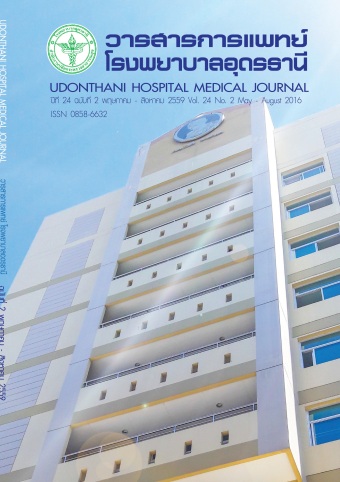การใช้ยาต้านการแข็งตัวของเลือดในกลุ่มผู้ป่วยความเสี่ยงสูง (ผู้สูงอายุ): กรณีศึกษา
คำสำคัญ:
ยาต้านการแข็งตัวของเลือด, การดูแลผู้สูงอายุ, ความเสี่ยงสูงบทคัดย่อ
ยาต้านการแข็งตัวของเลือด เป็นยาที่มีข้อบ่งใช้ในการป้องกันและควบคุมการเกิดลิ่มเลือดอุดตันในหลอดเลือด ภาวะดังกล่าวเป็นภาวะเสี่ยงที่พบได้ในกลุ่มประชากรผู้สูงอายุและกลุ่มผู้ป่วยที่มีความผิดปกติของระบบหัวใจและหลอดเลือด จากข้อบ่งชี้ดังกล่าวจึงมีการใช้ยาต้านการแข็งตัวของเลือดมากขึ้นโดยเฉพาะในกลุ่มผู้สูงอายุซึ่งพบว่ามีภาวะหัวใจเต้นพริ้ว (atrial fibrillation) บ่อย ๆ โดยการใช้ยาต้านการแข็งตัวของเลือดนั้นสามารถใช้ป้องกันการเกิดโรคหลอดเลือดสมองในผู้ป่วยที่มีภาวะหัวใจเต้นพริ้วได้แต่ยาดังกล่าวเป็นยาที่มีช่วงการรักษาแคบ (narrow therapeutic index) ซึ่งการติดตามผลการรักษาสามารถประเมินผลจากการตรวจวัดค่า INR (international normalized ratio) โดยค่ามาตรฐานที่พึงรับได้ในการป้องกันการเกิดภาวะลิ่มเลือดอุดตันคือ INR 2-3 หากค่า INR น้อยกว่า 2 มีโอกาสเกิดลิ่มเลือดอุดตันในหลอดเลือด (Thrombosi sevent)และหากได้ INR ค่าสูงเกิน 3 อาจทำให้เกิดภาวะเลือดออกผิดปกติ (Hemorrhagic event) ในผู้สูงอายุที่มีอายุมากกว่า 65 ปีมีความเสี่ยงทั้ง 2 ภาวะใกล้เคียงกัน ปัจจัยที่มีผลต่อการใช้ยาการแข็งตัวของเลือดได้แก่ เภสัชจลนศาสตร์ของยาต้านการแข็งตัวของเลือด การติดตามผลการรักษาและการปรับขนาดยาการเกิดภาวะเลือดออกผิดปกติ ความไม่สม่ำเสมอในการรับประทานยา การสื่อสารกับผู้ป่วย อันตรกิริยาระหว่างยาต้านการแข็งตัวของเลือดกับยาอื่นๆกับอาหารและกับโรค โดยเฉพาะในวัยสูงอายุที่ต้องการความระมัดระวังเป็นพิเศษในการจัดการเมื่อใช้ยาต้านการแข็งตัวของเลือด
วัตถุประสงค์ เพื่ออธิบายความรู้พื้นฐานและกลไกการออกฤทธิ์ของยาต้านการแข็งตัวของเลือด ปัจจัยที่มีผลต่อการออกฤทธิ์ อาการไม่พึงประสงค์และข้อควรระวังในการใช้ยาต้านการแข็งตัวของเลือด การติดตามผลการรักษาการจัดการเมื่อเกิดภาวะแทรกซ้อนจากการรักษาด้วยยาต้านการแข็งตัวของเลือดและการให้คำแนะนำในการดูแลตนเองแก่ผู้ป่วยและญาติผู้ดูแล โดยมีตัวอย่างและวิเคราะห์กรณีศึกษาซึ่งเป็นผู้สูงอายุที่ได้รับการรักษาด้วยยาต้านการแข็งตัวของเลือด จากความรู้ที่ได้คาดว่าจะเป็นประโยชน์ต่อบุคลากรในทีมสุขภาพโดยเฉพาะอย่างยิ่งทีมงานคลินิกยาต้านการแข็งตัวของเลือด (Warfarin clinic) ได้มีความเข้าใจสามารถให้การดูแลผู้สูงอายุที่ได้รับการรักษาด้วยยาต้านการแข็งตัวของเลือดได้อย่างมีประสิทธิผล ลดการเกิดภาวะแทรกซ้อนและลดอัตราการเข้ารับการรักษาในโรงพยาบาล
เอกสารอ้างอิง
2. บรรลุ ศิริพานิช, สถาพร ลีลานันทกิจ, วิไล พัววิไล, สุดารัตน์ ตันสุภสวัสดิกุล, วัฒนีย์ เย็นจิตร, ใยวรรณ ธนะมัยและคณะ. คู่มือแนวทางการจัดตั้งและดำเนินการคลินิกผู้สูงอายุสถาบันเวชศาสตร์ผู้สูงอายุกรมการแพทย์กระทรวงสาธารณสุข.กรุงเทพฯ: ชุมนุมสหกรณ์การเกษตรแห่งประเทศไทย;2548.
3. Gallagher AM, Van Staa TP, MurrayThomas T, et al. Population-based cohort study of warfarin-treated patients with atrial fibrillation: incidence of cardiovascular and bleeding outcomes. BMJ Open 2014; 4:e003839.
4. Perrero, P. P., Willoughby, D. F., Eggert, J. A., Counts, S. H. Warfarin therapy in older adults: Managing treatment in the primary care setting. JGerontolNurs2004; 30(7):45-54.
5. Friberg L, Rosenqvist M, Lip GY. Net clinical beneft of warfarin in patients with atrial fbrillation: a report from the Swedish atrial fibrillation cohort study. Circulation 2012;125:2298.
6. Ansell, J., Hirsh, J., Hylek, E., Jacobson, A., Crowther,M., Palareti, G. Pharmacology and management of the vitamin K antagonists. American College of Chest Physicians evidencebased clinical practice guidelines (8th edition). Chest 2008; 133(6 Suppl):160S-198S.
7. Palareti, G., Hirsh, J., Legnani, C., Manotti, C., D’Angelo, A., Pengo, V., et al., Oral anticoagulation treatment in the elderly: A nested, prospective, case control study. Arch Intern Med 2000;160:470-478.
8. Hirsh, J., Dalen, J. E., Deykin, D., Poller, L., Bussey, H. Oral anticoagulants: Mechanism of action, clinical effectiveness, and optimal therapeutic range. Chest 1995;108(4 Suppl):231S-246S.
9. พันธุ์เทพ อังชัยสุขศิริ, วิชัย อติชาตการ. Advance in anticoagulants. ใน: สมิง เก่าเจริญ, อาทิตย์ อังกานนท์, สุพจน์ ตุลยาเดชานนท์, ชาญ เกียรติ บุญศรี,สมศักดิ์ ตันรัตนากร, สินีดิษฐ บรรจงและคณะ. การประชุมวิชาการ: Ramathibodi clinical update in medicine 2005. กรุงเทพฯ: ออฟเซ็ทครีเอชั่น.หน้า 49-89.
10. ศรีจันทร์ พรจิราศิลป์. ยาป้องกันการแข็งตัวของเลือด. ใน: จุฑามณี สุทธิสีสังข์, รัชนี เมฆมณี, บรรณาธิการ.เภสัชวิทยาเล่ม 1. กรุงเทพฯ:นิวไทยมิตรการพิมพ์; 2546.หน้า 420-429.
11. Stergiopoulos K, Brown DL. Genotype-guided vs clinical dosing of warfarin and its analogues: meta-analysis of randomized clinical trials. JAMA Intern Med 2014; 174:1330.
12. Pirmohamed M, Burnside G, Eriksson N, Jorgensen, A, Hock Toh, Cheng, Nicholson, Toby, et al. A randomizedtrial of genotype-guided dosing of warfarin. N Engl J Med 2013; 369:2294.
13. Holbrook, A. M., Pereira, J. A., Labiris, R., McDonald, H., Douketis, J. D., Crowther, M., et al. Systematic overview of warfarin and its drug and food interactions. Arch Intern Med 2005;165:1095-1106.
14. Ferland, G. Vitamin K. In: B. A. Bowman, R. M. Russell,editors. Present knowledge in nutrition. 9th ed. Washington: International life science institute;2006.p.220-230.
15. Du Breuil, A. L., Umland, E. M. Outpatient management of anticoagulation therapy. Am Fam Physician 2007;75:1031-1042.
16. Rowin, J., Lewis, S. L. Spontaneous bilateral subdural hemetomas associated with chronic ginkgo biloba ingestion. Neurology 1996;46:1775-1776.
17. Ansell, J., Hirsh, J., Poller, L., Bussey, H., Jacobson, A., Hylek, E. The pharmacology and management of the vitamin K antagonists. The seventh ACCP conference on antithrombotic and thrombolytic therapy. Chest 2004; 126(3 Suppl):204S-235S.
18. Hirsh, J., Fuster, V.,Ansell, J., Halperin, J. L. American Heart Association/American College of Cardiology Foundation guide to warfarin therapy. J American CollCardiol
2003;41:1633-1652.
19. Landefeld, C. S., Beyth, R. J. Anticoagulant related bleeding: Clinical epidemiology, prediction, and prevention. Am J Med 1993;95:315-328.
20. คณะเภสัชศาสตร์ มหาวิทยาลัยมหิดล. Warfarin ทำให้เกิด skin necrosis. Retrieved June 2549;23:2008.
21. Gibbar-Clements, T., Shirrell, D., Dooley, R., Smiley, B. The challenge of warfarin therapy.Am JNurs 2000;100(3):38-40.
22. Turner, L. Keeping warfarin therapy in balance: Here’s what you-and your patientneed to know about keeping anticoagulant therapy safe and effective. Nursing 2006;36(11): 43-44.
23. Gage, B. F., Birman-Deych, E., Radford, M. J., Nilasena, D. S., Binder, E. F. Risk of osteoporotic fracture in elderly patients taking warfarin: Results from the National Registry of Atrial Fibrillation 2.Arch Intern Med 2006;166: 241–246.
24. ศิริพันธุ์ สาสัตย์. การพยาบาลผู้สูงอายุ: ปัญหาที่พบบ่อยและแนวทางในการดูแล. กรุงเทพฯ: แอคทีฟพริ้น; 2549.
25. Fuster, V., Rydn, L. E., Cannom, D. S., Crijns, H. J.,Curtis, A. B., Ellenbogen, K. A., et al. ACC/HA/ESC 2006 guidelines for the management of patients with atrial fbrillation–Executive summary. Circulation 2006;114:70-752.
26. Morrison, C. M., Gainsborough, N., Rajkumar, C. Warfarin versus aspirin in the elderly in primary prophylaxis for atrial fbrillation. Age Ageing 2007; 36(2):117-119.
27. Heneghan, C., Alonso-Coello, P., Garcia-Alamino, J. M., Perera, R., Meats, E., Glasziou, P. Selfmonitoring of oral anticoagulation: A systematic review and meta-analysis. Lancet2006;367:404-412.
28. Shireman, T. I., Mahnken, J. D., Howard, P. A., Kresowik, T. F., Hou, Q., Ellerbeck, E. F. Development of a contemporary bleeding risk model for elderly warfarin recipients. Chest 2006;130:1390-1396.
29. Ament, P. W., Bertolino, J. G., Liszewski, J. L. Clinical pharmacology: Clinically signifcant drug interactions. Am Fam Physician 2000; 61:1745-1754.
30. Garcia, D., Regan, S., Crowther, M., Hughes, R. A., Hylek, E. M. Warfarin maintenance dosing patterns in clinical practice: Implications for safer anticoagulation in the elderly population. Chest 2005; 127:2049-2056.
31. Douketis, J. D., Berger, P. B., Dunn, A. S., Jaffer, A. K.,Spyropoulos, A. C., Becker, R. C., et al. The perioperative management of antithrombotic therapy: American College of Chest Physicians evidence-based clinical practice guidelines (8th Edition). Chest 2008;133(6 Suppl):299S-339.
32. Holcomb, S. S. Coumadin (warfarin) therapy. Nursing 2006; 36(11):45-46.
ดาวน์โหลด
เผยแพร่แล้ว
รูปแบบการอ้างอิง
ฉบับ
ประเภทบทความ
สัญญาอนุญาต
การละเมิดลิขสิทธิ์ถือเป็นความรับผิดชอบของผู้ส่งบทความโดยตรง
ผลงานที่ได้รับการตีพิมพ์ถือเป็นลิขสิทธิ์ของผู้นิพนธ์ ขอสงวนสิทธิ์มิให้นำเนื้อหา ทัศนะ หรือข้อคิดเห็นใด ๆ ของบทความในวารสารไปเผยแพร่ทางการค้าก่อนได้รับอนุญาตจากกองบรรณาธิการ อย่างเป็นลายลักษณ์อักษร



